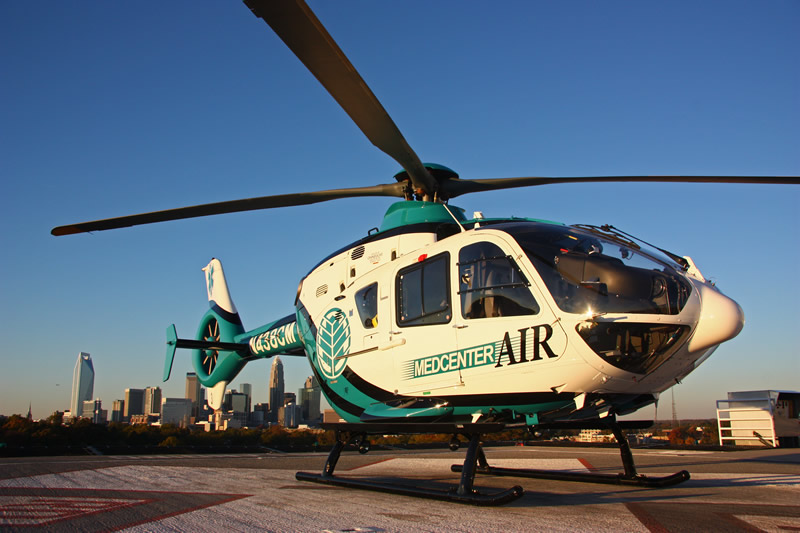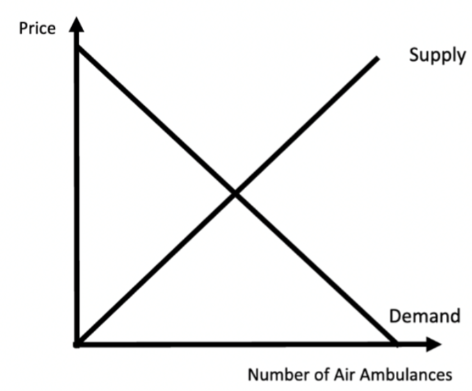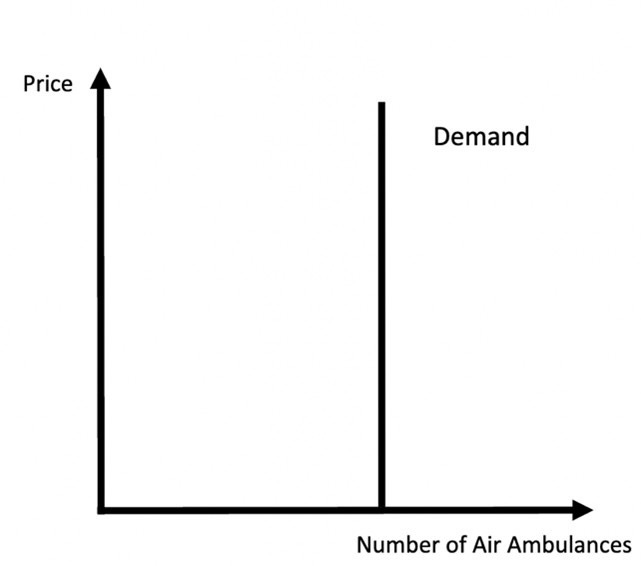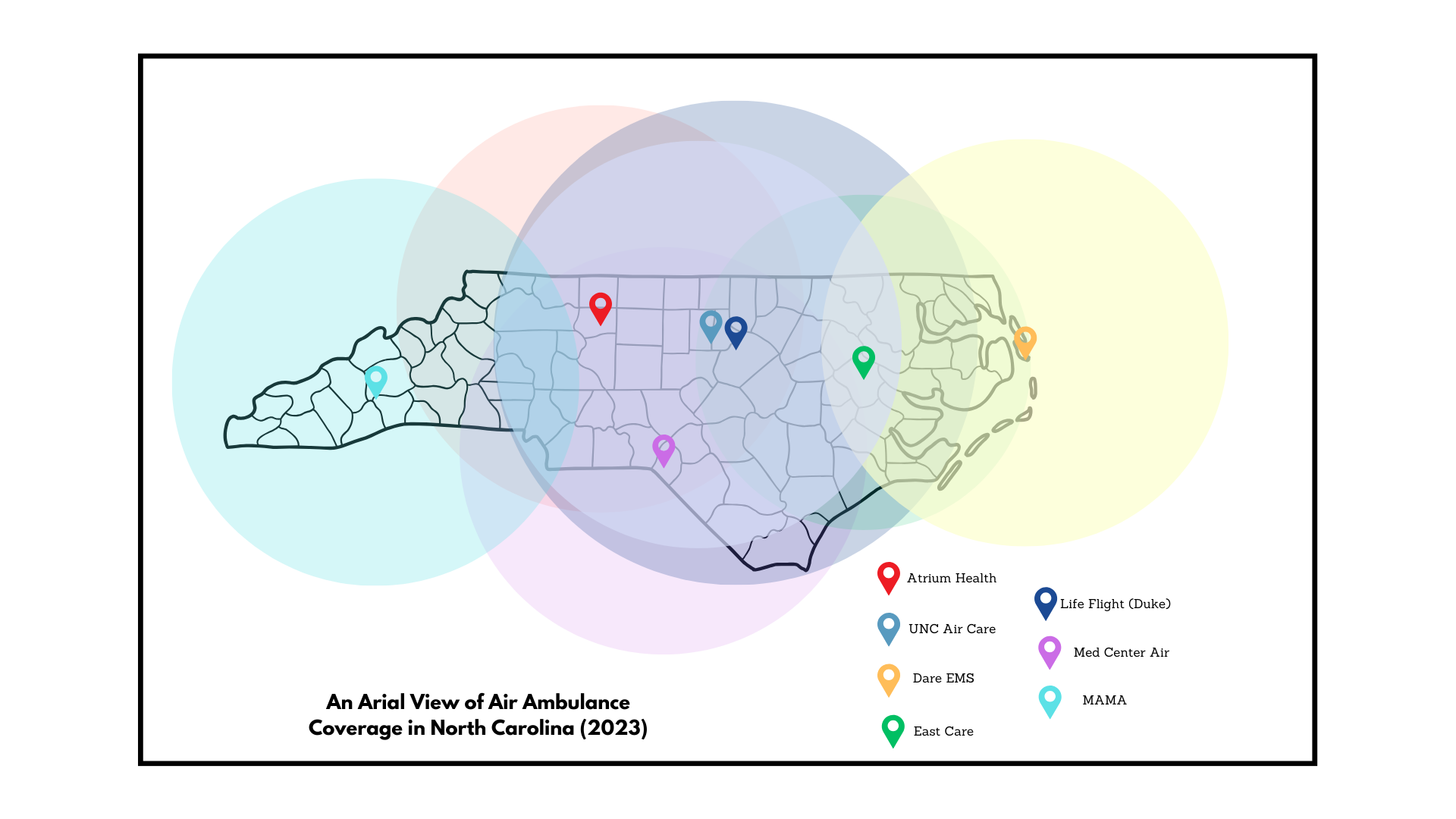
An Investigation of the Economics Behind Air Emergency Medical Services
Abstract¶
The use of air ambulance services, a critical component of emergency medical response, has become increasingly prevalent in transporting critically ill or injured patients to medical emergency sites. This essay aims to provide a comprehensive understanding of air ambulance services by exploring their definition, importance in trauma care, and the economic and personal finance aspects associated with these life-saving interventions. The significance of air ambulance services in trauma care is underscored by empirical research, highlighting the advantages of high speed, rapid transportation, and access to specialized medical teams for trauma patients. Furthermore, the laws and current economic conditions of air ambulance services is examined through cost comparisons and analyses of factors influencing cost effectiveness. The findings shed light on the balance between the economic viability of air ambulance services and their life-saving potential. Any approach aimed at addressing these economic issues must consider the many perspectives: economic, medical, political, and more.
Introduction¶
Air ambulance services are an essential part of emergency medical response, playing a crucial role in quickly transporting seriously ill or injured patients to medical emergency locations. This essay seeks to offer a thorough insight into air ambulance services by examining their definition, significance in trauma care, and the complex economic and personal financial factors linked to these life-saving interventions.
What Are Air Ambulances?¶
To comprehend the significance of air ambulance services, it’s essential to define them. According to Nahan (2023), an air ambulance Figure 1 is a specialized medical transport service that utilizes aircraft for the rapid transportation of critically ill or injured patients to medical emergency sites.
This definition encapsulates the essence of a service designed for swift response, emphasizing high speed, rapid transportation, and suitability for long-distance transports.
Importance of Air Ambulance Services in Trauma Care¶
The importance of air ambulance services in trauma care is underscored by research, such as the study conducted by Haut et al. (2012). This research explores the association between helicopter and ground emergency medical services, delving into the impact of helicopter transport on traumatically injured patients. Covering 61,909 patients transported by helicopter and 161,566 by ground, the study reveals that helicopter transport is associated with improved survival to hospital discharge for major trauma patients in Level I or Level II trauma centers Haut et al., 2012.
However, the significance of this impact is debated due to limited resources and acknowledged study limitations. The study highlights the complexities of assessing the effectiveness of air ambulance services, including the lack of regression model testing and the inability to account for treatment assignment differences. Despite these challenges, the research indicates statistically significant greater odds of survival for patients transported by helicopter, especially for those in Level I trauma centers.

Figure 1:This figure displays a version of an air ambulance maintained by MedCenter Air.
The advantages of air ambulance services, including high speed, rapid transportation, and access to specialized medical teams, align with the critical needs of trauma patients. The swiftness of response and the potential for improved survival rates make air ambulances a crucial component in the continuum of trauma care. As we explore the economic and personal finance aspects of air ambulance services, it is crucial to bear in mind the life-saving impact these services can have on individuals facing critical medical emergencies.
Cost Comparison between Air Ambulance and Ground Emergency Medical Services¶
Exploring the economic landscape of air ambulance services in comparison to ground emergency medical services unveils a complex interplay of factors influencing cost-effectiveness. Delgado et al. (2013) delve into this intricacy by assessing the cost-effectiveness of helicopter versus ground emergency medical services for trauma scene transport in the United States. The study, analyzing 69,700 helicopter transports for trauma, reveals a critical threshold for cost-effectiveness. Helicopter EMS requires a 15 percent reduction in mortality to offset higher costs, transport risks, and overtriage, even with a 10,000 dollar higher cost in rural areas Delgado et al., 2013. What this means, is that from an economic perspective, for the higher cost of air ambulances to be justified, patients using the service should be 15 percent more likely to survive to hospital discharge.
It is important to recognize the difference between the usage of these services in urban versus rural settings. Urban settings are more accessible to ground ambulances and are typically shorter distance routes for air ambulances to use. This, among other factors, is what contributes to the higher cost of air emergency services in rural areas as compared to urban areas.
Factors Influencing Cost Effectiveness¶
To comprehend the economic nuances, it’s imperative to dissect the factors influencing the cost-effectiveness of air ambulance services. One factor is the magnitude of costs incurred by the treatment of trauma in any setting, a leading cause of years of life lost, amounting to 406 billion dollars per year Delgado et al., 2013.
The study by Michaels et al. (2019) contributes further insights by reviewing the National Trauma Data Bank for outcomes in transferred trauma patients transported by helicopter or ground ambulance. Despite the higher costs and limitations of helicopter transport, patients transferred by air show improved survival rates. Logistic regression adjusted for confounders indicates a 57 percent lower likelihood of death for helicopter-transported trauma patients Michaels et al., 2019.
Analysis of Cost Effectiveness Studies¶
Analyzing cost-effectiveness studies sheds light on the balance between the economic viability of air ambulance services and their life-saving potential. Delgado et al. (2013) emphasize the need for a mortality reduction threshold of 15 percent, indicating that the economic justification for helicopter EMS hinges on achieving this improvement in patient outcomes. The results of Michaels analysis, on a first glance, appear to meet this minimum adjustment of fifteen percent in mortality rates.
This analysis underscores the intricacies involved in assessing the cost-effectiveness of air ambulance services. It’s not merely about comparing the direct costs but understanding the broader economic impact of trauma on families, EMS, and our broader healthcare system.
Relationship between Cost and Increase in Survival Rates¶
The relationship between cost and an increase in survival rates is a critical aspect of the economic evaluation of air ambulance services. The study by Haut et al. (2012) provides valuable insights by linking helicopter transport to statistically significant greater odds of survival, especially for patients in Level I trauma centers. The adjusted analysis indicates a 1.5 percent increased absolute rate of improved survival for helicopter transport to Level I trauma centers Haut et al., 2012. The adjusted analysis conducted by Haut considers that patients whose healthcare providers decided to transport via air ambulance are typically in a more a critical condition.
It is important to note the distinction between the conclusion of Haut that a 1.5 percent increase in survival was observed with Michaels’ conclusion that a 57 percent increase in survival was observed. This is likely due to a difference in the considerations taken about the patient’s initial condition when using a particular mode of medical transport was made by an emergency medical response team.
While these services entail a financial burden, the potential improvement in survival rates, especially for patients in critical conditions, adds a layer of complexity to the economic evaluation. This is where the field of behavioral economics enters into view: how does an increased chance of survival justify the increased cost in the human mind? Further research could be conducted to analyze this.
Addresssing The High Costs of Air Ambluance Services¶
550,000 annual air ambulance users face a median cost of 36,000 dollars per trip D. Goldbeck (n.d.).
The market concentration by notably few firms and the lack of insurance incentives contribute significantly to these exorbitant costs. Notably, the government’s hands are tied due to the Airline Deregulation Act of 1978 Cannon, 1978, limiting its authority to address market distortion in the air ambulance industry.
Addressing the pricing and billing challenges is crucial for making air ambulance services more economically sustainable. You might expect a standard supply and demand curve as in many industries (Figure 2), though Goldbeck and Mahoney D. Goldbeck, n.d. represent the actual vertical demand curve in the air ambulance industry (Figure 3).

Figure 2:This figure displays an ideal supply and demand curve for the air ambulance market D. Goldbeck, n.d.. As the supply of air ambulances increases, the price should, in theory, decrease with more ambulances.

Figure 3:This figure displays the actual supply and demand curve for the air ambulance market D. Goldbeck, n.d.. As the supply of air ambulances increases, the price remains unaffected as the demand is not dependent on the number of air ambulance services. Please note this is a simplification of the actual market conditions
The difference between Figure 2, which represents a standard economic market, and Figure 3, which represents the market of air emergency medicine, is that as the supply of air ambulances increases, the price remains unaffected. In a normal market, when more of a good becomes available, the equillibrium point of the supply-demand curve causes a lower price. Are vertical demand market conditions desired in a life-and-death market? This unique aspect creates a complex economic landscape, where the urgency of the service complicates traditional market dynamics.
Regulatory and policy considerations play a pivotal role in addressing the high costs of air ambulance services. Striking a balance between ensuring fair pricing for consumers and maintaining the financial viability of air ambulance providers requires a nuanced approach. When alterations to the field or air ambulance services could cause lives to be lost, any action taken to address these economic issues must be done so with the utmost caution.
Economic Impact of Air Amublance Services¶
The economic impact of air ambulance services extends beyond the immediate costs borne by patients. It encompasses a broader perspective, including the impact on the healthcare system and the financial burden imposed on patients and insurance providers.
Examining the broader healthcare system, Brainy Insights Ltd (2023) points out that trauma, stroke, and heart attack incidences drive the demand for air medical services. The rising incidence of chronic diseases that Brain Insights LTD forecasts will further contribute to the expansion of the market for air ambulance services. As more and more people are facing life threatening conditions in the not-too-distant future, the demand for these services will increase, begging the question, can our current system handle such demand?
The financial burden on patients and insurance providers is a critical aspect of the economic impact. The high median cost of 36,000 dollars per trip poses a significant financial challenge for individuals requiring air ambulance services. Moreover, the concentration of market power among a relatively small number of firms exacerbates the financial strain on consumers.

Figure 4:This figure displays the air ambulance service territories throughout North Carolina in 2023.
The high barriers to entry in the air ambulance services industry create significant difficulties for new entrants. These barriers, such as high startup costs, stringent regulations, and the need for specialized equipment and expertise, make it challenging for new companies to enter the market. As a result, the lack of competition contributes to the concentration of market power among a few firms, further exacerbating the financial strain on consumers and limiting options for patients and insurance providers.
Air Ambulance Services Across North Carolina¶
When examining the state of North Carolina and the United States, it becomes apparent that issues concerning air ambulance services are prevalent. Figure 4, which has been compiled to demonstrate the availability of such services in North Carolina, reveals that only a few helicopters are operational in certain regions. Most of the helicopter stations depicted house only one helicopter, yet they are responsible for covering extensive areas.
Consequently, when one helicopter is unavailable due to prior engagements, it strains the system, necessitating helicopters to travel towards the outer boundaries of their designated regions, as indicated by the circles surrounding each station. As demand escalates, as previously discussed, this strain on the system intensifies. This shortage of available helicopters in North Carolina will likely extend to a national level within the United States in the coming years.
Conclusions¶
In conclusion, the analysis of air ambulance services reveals a complex landscape involving medical, economic, and policy considerations. The significance of air ambulance services in trauma care, particularly in improving survival rates for major trauma patients, cannot be overstated. The speed, access to specialized care, and rapid transportation offered by air ambulances play a crucial role in addressing critical medical situations.
The cost comparison between air ambulance and ground emergency medical services brings to light various factors influencing cost effectiveness. Delgado et al. (2013) emphasize the need for a 15 percent reduction in mortality for helicopter EMS to be cost-effective, even with higher costs in rural areas. Michaels et al. (2019) further highlight improved survival outcomes for trauma patients transported by helicopter despite higher costs.
Addressing the high costs of air ambulance services is imperative for ensuring accessibility and affordability. Goldbeck and Mahoney D. Goldbeck, n.d. shed light on the challenges posed by market concentration and the lack of regulatory authority to address pricing issues. Striking a balance between fair pricing and economic sustainability requires both regulatory and policy considerations.
The economic impact of air ambulance services extends beyond immediate costs. Trauma, stroke, and heart attack incidences drive demand, contributing to the market’s expansion Brainy Insights Ltd, 2023. However, the financial burden on patients, with a median cost of 36,000 dollars per trip, poses challenges highlighting the need for comprehensive solutions that consider both healthcare providers and patients.
In summary, the economic sustainability of air ambulance services demands a multifaceted approach. Regulatory frameworks must address pricing challenges, ensuring fair practices that balance the urgency of service with consumer protection. The economic impact on both the healthcare system and individual patients underscores the importance of finding solutions that foster accessibility, affordability, and sustainability in air ambulance services. Steps to find these solutions must be done soon or else we might find ourselves in an under-resourced and under-prepared nation to address the rising number of medical emergencies.
The author thanks Ms. Karima Radwan from Raleigh Charter High School and Ms. Beth Thomason from the North Carolina School of Science and Math for their assistance with this work without which this research would not have been conducted.
Copyright © 2024 Langbo. This is an open-access article distributed under the terms of the Creative Commons Attribution 4.0 International license, which enables reusers to distribute, remix, adapt, and build upon the material in any medium or format, so long as attribution is given to the creator.
- Nahan, D. T. N. N. (2023). What Is an Air Ambulance? https://www.icliniq.com/articles/first-aid-and-emergencies/air-ambulance
- Haut, S. M., Galvagno, E. R., Zafar, S. N., Millin, M. G., Efron, D. T., Koenig, G. J., Baker, S. P., Bowman, S. M., Pronovost, P. J., & Haider, A. H. (2012). Association Between Helicopter vs Ground Emergency Medical Services and Survival for Adults With Major Trauma. JAMA, 307(15), 1602. 10.1001/jama.2012.467
- Delgado, M. K., Staudenmayer, K. L., Wang, N. E., Spain, D. A., Weir, S., Owens, D. K., & Goldhaber-Fiebert, J. D. (2013). Cost-Effectiveness of Helicopter Versus Ground Emergency Medical Services for Trauma Scene Transport in the United States. Annals of Emergency Medicine, 62(4), 351-364.e19. 10.1016/j.annemergmed.2013.02.025
- Michaels, D., Pham, H., Puckett, Y., & Dissanaike, S. (2019). Helicopter versus ground ambulance: review of national database for outcomes in survival in transferred trauma patients in the USA. Trauma Surgery & Acute Care Open, 4(1), e000211. 10.1136/tsaco-2018-000211
- D. Goldbeck, M. M. (n.d.). Addressing the High Costs of Air Ambulance Services. In AAF. Retrieved April 29, 2024, from https://www.americanactionforum.org/insight/addressing-the-high-costs-of-air-ambulance-services/
- Cannon, H. W. (1978). 95th Congress (1977-1978): Air-line Deregulation Act. https://www.congress.gov/bill/95th-congress/senate-bill/2493
- ltd Brainy Insights Ltd. (2023). Air Ambulance Market Size Worth $20.07 Billion by 2030: The Brainy Insights. In GlobeNewswire News Room. https://www.globenewswire.com/news-release/2023/02/21/2612639/0/en/Air-Ambulance-Market-Size-Worth-20-07-Billion-by-2030-The-Brainy-Insights.html
